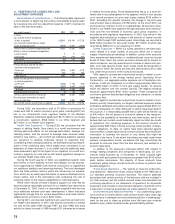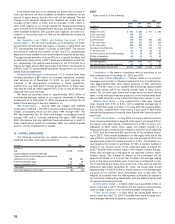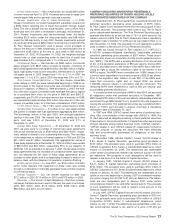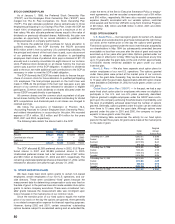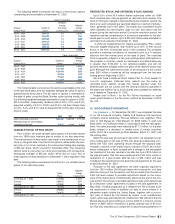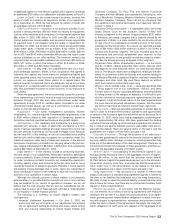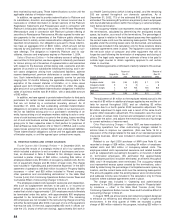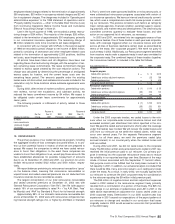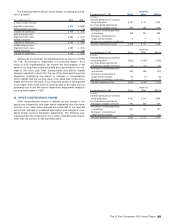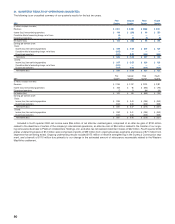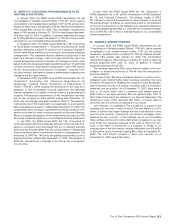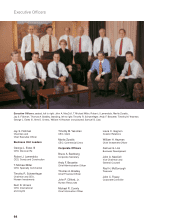Travelers 2002 Annual Report Download - page 86
Download and view the complete annual report
Please find page 86 of the 2002 Travelers annual report below. You can navigate through the pages in the report by either clicking on the pages listed below, or by using the keyword search tool below to find specific information within the annual report.
fees received by each party. These indemnifications survive until the
applicable statutes of limitation expire.
In addition, we agreed to provide indemnification to Platinum and
its subsidiaries, directors and employees for losses incurred due to
inaccurate or omitted information in certain sections of the Platinum
Registration Statements and Prospectuses used in connection with
Platinum’s initial public offering of securities, or the Private Placement
Memorandum used in connection with Platinum’s private offering of
securities to Renaissance Reinsurance.We also agreed to make cer-
tain payments to the underwriters of the Platinum public offerings if
Platinum fails to satisfy certain indemnification obligations to them in
specified circumstances. Our obligations pursuant to these indemni-
ties have an aggregate limit of $400 million, which amount will be
reduced by any payments we make to investors in the public or pri-
vate offerings. The obligation to indemnify Platinum and its sub-
sidiaries, directors and employees expires on November 1, 2004.
Sales of Business Entities — In the ordinary course of selling busi-
ness entities to third parties, we have agreed to indemnify purchasers
for losses arising out of breaches of representations and warranties
with respect to the business entities being sold, covenants and obli-
gations of us and/or our subsidiaries following the closing, and in cer-
tain cases obligations arising from undisclosed liabilities, adverse
reserve development, premium deficiencies or certain named litiga-
tion. Such indemnification provisions generally survive for periods
ranging from 12 months following the applicable closing date to the
expiration of the relevant statutes of limitation, or in some cases
agreed upon term limitations. As of December 31, 2002, the aggre-
gate amount of our quantifiable indemnification obligations in effect for
sales of business entities was $1.9 billion, with a deductible amount
of $62 million.
In addition, we have agreed to provide indemnification to third party
purchasers for certain losses associated with sold business entities
that are not limited by a contractual monetary amount. As of
December 31, 2002, we had outstanding unlimited indemnification
obligations in connection with the sales of certain of our business enti-
ties for tax liabilities arising prior to a purchaser’s ownership of an
entity, losses arising out of employee matters relating to acts or omis-
sions of such business entity or us prior to the closing, losses resulting
out of such sold business entities being deemed part of The St. Paul
group prior to their respective sales to third parties for purposes of
Internal Revenue Code Section 412 or Title IV of ERISA, and in some
cases losses arising from certain litigation and undisclosed liabilities.
These indemnification obligations survive until the applicable statutes
of limitation expire, or until the agreed upon contract terms expire.
18. RESTRUCTURING AND OTHER CHARGES
Fourth-Quarter 2001 Strategic Review — In December 2001, we
announced the results of a strategic review of all of our operations,
which included a decision to exit a number of businesses and coun-
tries, as discussed in Note 5. Related to this strategic review, we
recorded a pretax charge of $62 million, including $46 million of
employee-related costs, $9 million of occupancy-related costs, $4 mil-
lion of equipment charges and $3 million of legal costs. The charge
was included in “Operating and administrative expenses” in the 2001
statement of operations; with $42 million included in “Property-liability
insurance — other” and $20 million included in “Parent company,
other operations and consolidating eliminations” in the table titled
“Income (Loss) from Continuing Operations Before Income Taxes and
Cumulative Effect of Accounting Change” in Note 21.
The employee-related costs represent severance and related ben-
efits such as outplacement services to be paid to, or incurred on
behalf of, employees to be terminated by the end of 2002. We esti-
mated that a total of approximately 1,200 employees would ultimately
be terminated under this action, with approximately 800 employees
expected to be terminated by the end of 2002. The remaining
400 employees are not included in the restructuring charge since they
will either be terminated after 2002 or are part of one of the operations
that may be sold. Of the total, approximately 650 work in offices out-
side the U.S. (many of which are closing), approximately 300 work in
84
our Health Care business (which is being exited), and the remaining
250 are spread throughout our domestic operations. As of
December 31, 2002, 713 of the estimated 800 positions had been
eliminated.The remaining 87 positions are primarily due to employees
who found alternate positions within the company or external employ-
ment before termination.
The occupancy-related cost represents excess space created by
the terminations, calculated by determining the anticipated excess
space, by location, as a result of the terminations.The percentage of
excess space in relation to the total leased space was then applied to
the current lease costs over the remaining lease period. The amounts
payable under the existing leases were not discounted, and sublease
income was included in the calculation only for those locations where
sublease agreements were in place. The equipment costs represent
the net book value of computer and other equipment that will no
longer be used following the termination of employees and closing of
offices. The legal costs represent our estimate of fees to be paid to
outside legal counsel to obtain regulatory approval to exit certain
states or countries.
The following presents a rollforward of activity related to this accrual.
Reserve at Reserve at
Original Pre- Dec. 31, Dec. 31,
Charges to earnings: Tax Charge 2001 Payments Adjustments 2002
(In millions)
Employee-related $ 46 $ 46 $(33) $ 1 $ 14
Occupancy-related 9 9 (1) — 8
Equipment charges 4 N/A N/A N/A N/A
Legal costs 3 3 (1) (2) —
Total $ 62 $ 58 $(35) $ (1) $ 22
The adjustment of $1 million to the employee related accrual is the
net result of $3 million in additional charges applied as we met the cri-
teria for accrual throughout 2002, and an offsetting $2 million
decrease due to a fourth quarter 2002 revaluation adjustment. The
$2 million adjustment to legal costs was a result of the same fourth
quarter 2002 revaluation adjustment. This revaluation was the result
of a review of actual costs incurred and anticipated costs yet to be
paid under the action, and adjusts the remaining restructuring charge
to current estimates of reserve need.
Other Restructuring Charges — Since 1997, we have recorded in
continuing operations four other restructuring charges related to
actions taken to improve our operations. (Also see Note 16 for a
discussion of the charge related to the sale of our standard personal
insurance business, which was included in discontinued operations
in 1999.)
Related to our April 2000 purchase of MMI (see Note 6), we
recorded a charge of $28 million, including $4 million of employee-
related costs and $24 million of occupancy-related costs. The
employee-related costs represented severance and related benefits
such as outplacement counseling to be paid to, or incurred on behalf
of, terminated employees. We estimated that approximately
130 employee positions would be eliminated, at all levels throughout
MMI, and 119 employees were terminated. The occupancy-related
cost represented excess space created by the terminations, calcu-
lated by determining the percentage of anticipated excess space, by
location, and the current lease costs over the remaining lease period.
The amounts payable under the existing leases were not discounted,
and sublease income was included in the calculation only for those
locations where sublease agreements were in place.
The charge was included in “Operating and administrative
expenses” in the 2000 statement of operations and in “Property-liabil-
ity insurance — other” in the table titled “Income (Loss) from
Continuing Operations Before Income Taxes and Cumulative Effect of
Accounting Change” in Note 21.
In August 1999, we announced a cost reduction program designed
to enhance our efficiency and effectiveness in a highly competitive
environment. In the third quarter of 1999, we recorded a pretax
charge of $60 million related to this program, including $25 million in


